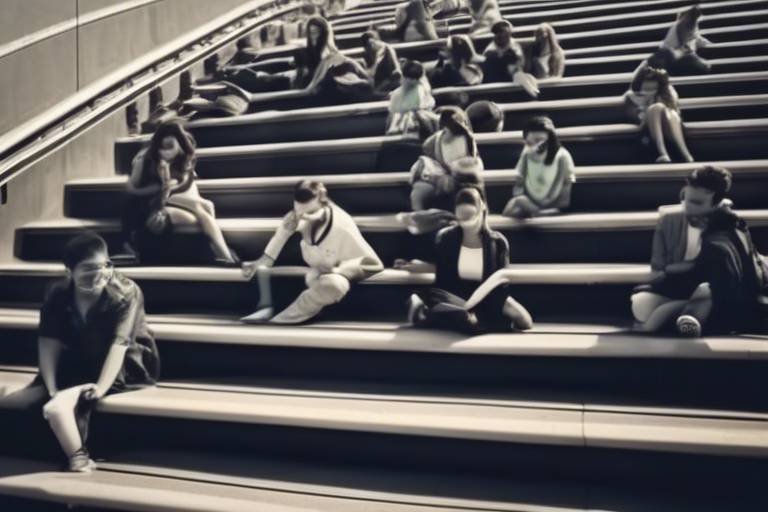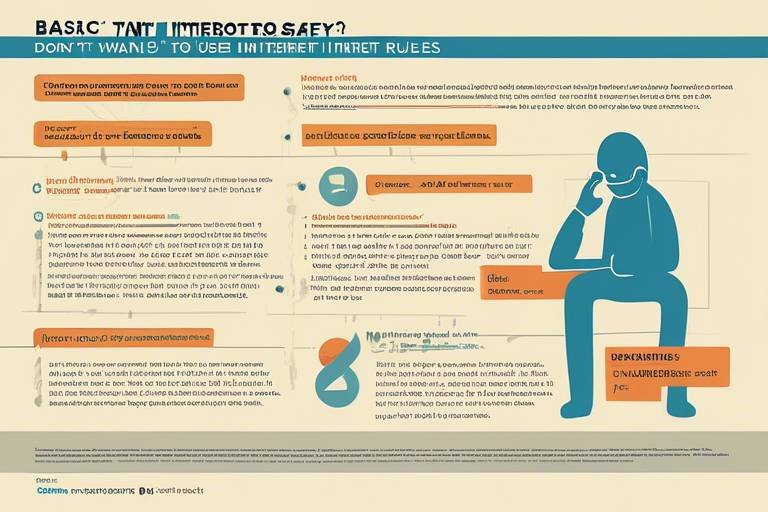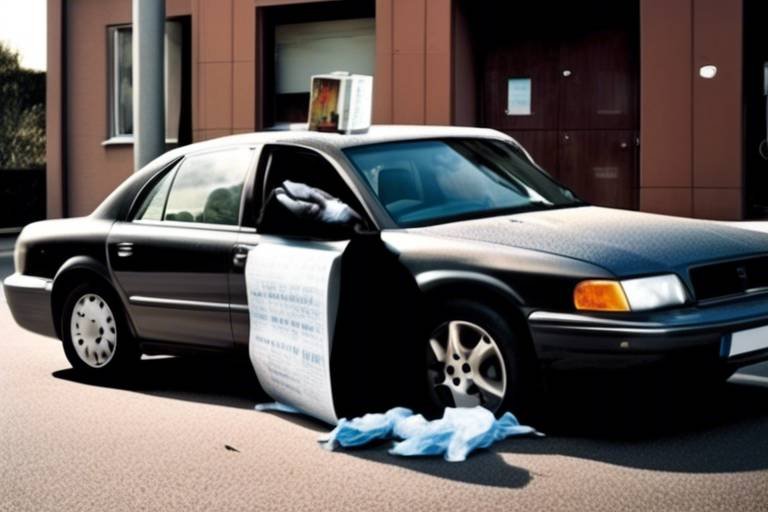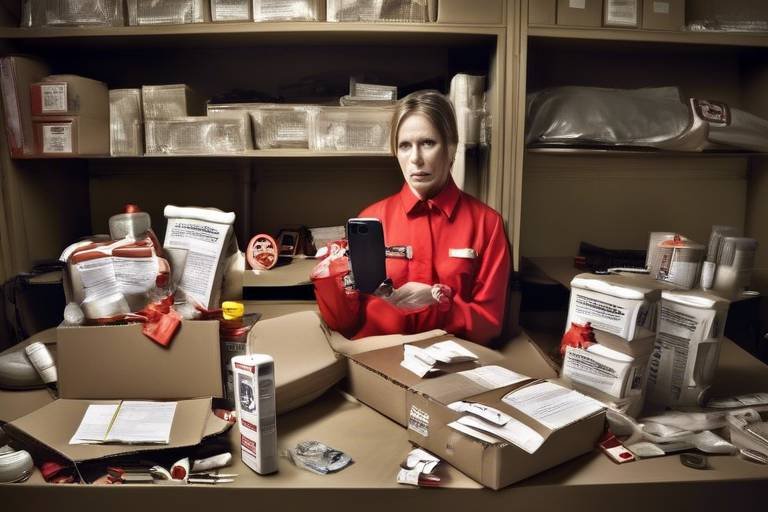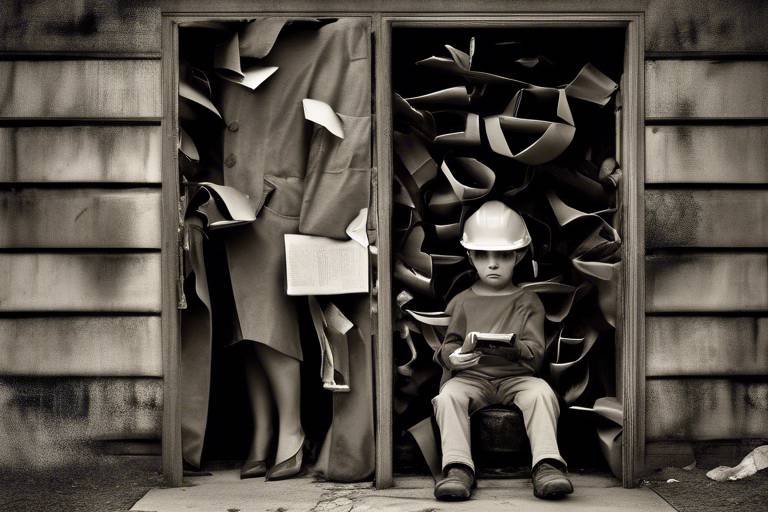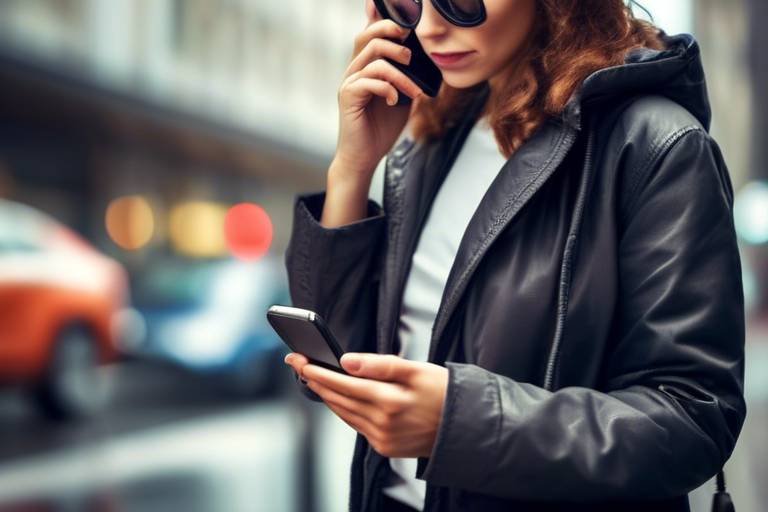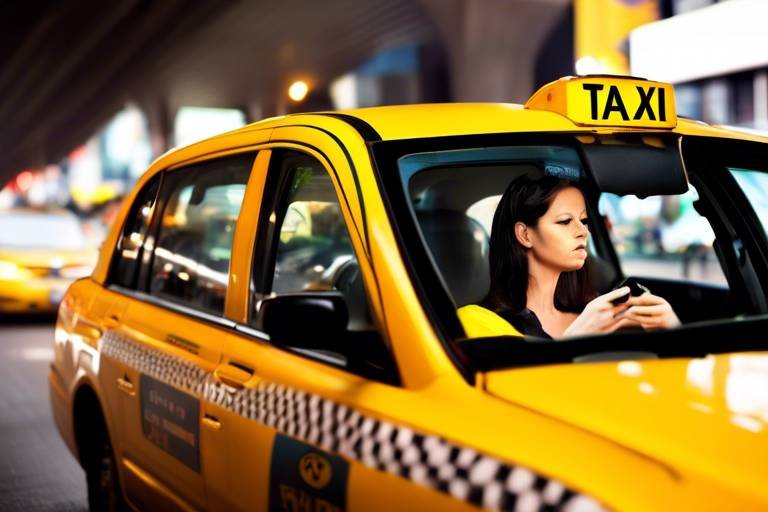Steps to Ensure Your Safety While Carpooling
Carpooling can be a fantastic way to save money, reduce your carbon footprint, and even make new friends along the way. However, it’s essential to keep safety at the forefront of your mind when you decide to share a ride with others. Whether you're a seasoned carpooler or just starting out, understanding the necessary steps to ensure a secure and enjoyable experience is crucial. In this article, we'll explore various safety measures, tips, and guidelines to help you navigate the carpooling landscape confidently.
When it comes to carpooling, trust is paramount. Selecting the right carpool partners can significantly influence your overall experience. Start by assessing potential partners through personal references or mutual acquaintances. You wouldn't want to jump into a car with someone you just met, right? Consider conducting a casual background check—think of it as a first date, but with more wheels involved! Ask questions about their driving history and any previous carpooling experiences. This way, you can gauge their reliability and ensure you're riding with someone who values safety as much as you do.
Once you've found suitable carpool partners, it’s time to lay down some ground rules. Establishing clear expectations can help avoid misunderstandings and keep everyone on the same page. Discuss key topics such as:
- Pick-up and drop-off times
- Responsibilities for gas or tolls
- Music preferences and conversation topics
By having an open dialogue about these elements, you can create a smooth and enjoyable carpooling environment where everyone feels comfortable and respected.
Before hitting the road, it’s vital to ensure that the vehicle is in tip-top shape. Regular vehicle maintenance is not just good practice; it's a life-saver. Consider implementing a safety checklist that includes:
| Safety Check | Frequency |
|---|---|
| Tire Pressure | Weekly |
| Brake Functionality | Monthly |
| Headlights and Taillights | Weekly |
| Windshield Wipers | Monthly |
By keeping your vehicle well-maintained, you not only ensure your safety but also that of your passengers.
Being prepared for emergencies can make all the difference. Imagine being stranded on the side of the road with no way to call for help. To avoid such scenarios, carry essential items in your car, including:
- A first aid kit
- Emergency contact numbers
- A flashlight and extra batteries
- Roadside assistance information
Having these items on hand can provide peace of mind and ensure that you’re ready for any situation that may arise during your carpooling adventures.
Effective communication is key to a safe carpool experience. Make it a point to stay connected with your carpool partners during rides. Share your location using apps or text messages, especially if you're running late or if plans change unexpectedly. This transparency builds trust and allows everyone to stay informed, reducing anxiety and ensuring that everyone is safe.
Having a consistent pick-up and drop-off routine can enhance safety significantly. Choose safe locations that are well-lit and familiar to all participants. Avoid isolated or high-traffic areas where risks may be higher. Additionally, establish a timeline that works for everyone, ensuring that no one feels rushed or unsafe during the process.
Before you start carpooling, it’s crucial to understand your insurance coverage. Not all policies cover carpooling activities, so check with your provider to clarify what is included. Make sure that all participants are adequately protected in case of an accident. This knowledge not only safeguards you financially but also contributes to a sense of security among all carpool members.
While carpooling can be rewarding, it's essential to remain vigilant. Be aware of potential warning signs that could indicate a problem. These red flags may include:
- Inconsistent or evasive communication
- Unusual behavior or attitudes
- Frequent changes in plans or routes
If you notice any of these signs, don’t hesitate to address your concerns. Open communication can often resolve issues before they escalate, ensuring a safer environment for everyone involved.
Creating a network of reliable carpoolers promotes a safer environment for all. Consider joining local community groups or online forums where carpoolers share experiences and tips. By fostering a community of responsible participants, you can enhance overall safety and create a supportive network that benefits everyone.
Q: What should I do if I feel uncomfortable with my carpool partner?
A: Trust your instincts. If you feel uncomfortable, it’s okay to seek alternative arrangements or discuss your concerns with your partner.
Q: How often should I perform vehicle safety checks?
A: Regular checks should be performed weekly, with more comprehensive inspections monthly to ensure everything is functioning properly.
Q: What items should I include in my emergency kit?
A: Essential items include a first aid kit, flashlight, blanket, water, and a list of emergency contacts.

Choosing the Right Carpool Partner
When it comes to carpooling, one of the most crucial steps is . Think about it: you're sharing a confined space with someone, often for extended periods. It’s like inviting a stranger into your living room—would you just let anyone through the door? Absolutely not! So, how do you ensure that your carpool buddy is trustworthy and reliable? Here are some essential tips to help you make that decision.
First off, consider conducting a background check. This might sound a bit extreme, but in today's world, it's becoming increasingly common to verify someone's credentials before entering into any arrangement, especially one that involves shared transportation. You can use various online services to check for any red flags in a potential carpool partner's history. This is especially important if you’re connecting through social media or ride-sharing apps where you might not know the person well.
Next, don’t hesitate to ask for personal references. If your potential carpool partner has friends or colleagues who can vouch for their character, that’s a good sign. A simple conversation can reveal a lot about someone’s reliability. You could ask questions like:
- How long have you known this person?
- Would you feel comfortable sharing a ride with them?
- Have they ever been involved in any incidents while driving?
Another aspect to consider is shared values and habits. It's essential that your carpool partner aligns with your expectations regarding punctuality, cleanliness, and even music preferences. For instance, if you're someone who enjoys a quiet ride to focus on your day ahead, you might want to steer clear of someone who loves belting out tunes at the top of their lungs. Having a conversation about these preferences can help set the tone for a harmonious carpool experience.
Furthermore, don’t underestimate the power of a trial run. Before committing to a regular carpool arrangement, consider taking a short trip together. This will allow you to gauge each other's driving style and comfort level. Pay attention to how they handle the vehicle, their road etiquette, and how they communicate during the ride. Do they respect your space, or do they dominate the conversation? These subtle cues can speak volumes about how well you might get along in the long run.
Lastly, trust your gut. If something feels off during the initial conversations or trial runs, don’t ignore that feeling. It’s always better to be safe than sorry. Remember, carpooling should be a mutually beneficial arrangement where everyone feels comfortable and secure. By taking the time to choose the right partner, you’re not just ensuring your own safety; you’re contributing to a positive carpooling culture.
In summary, choosing the right carpool partner involves a combination of background checks, personal references, shared values, trial runs, and trusting your instincts. By following these steps, you can significantly enhance your carpooling experience, making it not only safe but enjoyable as well.

Setting Clear Ground Rules
When it comes to carpooling, is like laying the foundation of a sturdy house. Without a solid base, everything can crumble, and misunderstandings can lead to frustration or even unsafe situations. So, how do you create these essential guidelines? First, it's important to gather all participants and have an open discussion about expectations. This is the time to talk about schedules, responsibilities, and any other pertinent details that will make the carpool experience smooth and enjoyable for everyone involved.
One of the first things to establish is the pick-up and drop-off times. Will everyone meet at the same location, or will there be multiple stops? Being clear about these logistics helps everyone plan their day without feeling rushed or confused. Next, discuss who will be responsible for driving on specific days. This not only distributes the workload evenly but also ensures that everyone knows who to rely on for each trip. You might even want to create a simple
| Day | Driver | Pick-Up Time | Drop-Off Time |
|---|---|---|---|
| Monday | John | 8:00 AM | 5:00 PM |
| Tuesday | Sarah | 8:00 AM | 5:00 PM |
| Wednesday | Mike | 8:00 AM | 5:00 PM |
Additionally, it’s crucial to discuss cost-sharing. If gas expenses are involved, how will you split the costs? Will everyone chip in equally, or will the driver receive a little extra for wear and tear? Establishing a transparent system for sharing expenses can prevent awkward conversations later on. You might even want to set up a digital payment method for convenience.
Another important aspect is to talk about behavioral expectations. This includes everything from music choices to conversation topics. For instance, some people might prefer a quiet ride to work, while others might enjoy a lively chat. By discussing these preferences upfront, you can create a comfortable atmosphere for everyone. Don't hesitate to address any rules regarding phone use, especially if it distracts the driver. After all, safety should always be your top priority!
Finally, don’t forget to establish a protocol for communication. If someone is running late or needs to cancel, how should they inform the group? Setting up a group chat or a shared calendar can be incredibly helpful for keeping everyone in the loop. This way, if plans change, everyone can adjust accordingly without any hassle.
In summary, setting clear ground rules is not just about laying down the law; it’s about fostering a respectful and enjoyable carpooling environment. By discussing schedules, responsibilities, cost-sharing, behavioral expectations, and communication methods, you create a framework that enhances safety and satisfaction for everyone involved. So, gather your carpool partners, have that chat, and watch how a little communication can go a long way!
- What should I do if I feel uncomfortable with a carpool partner?
It's important to trust your instincts. If you feel uneasy, consider discussing your concerns with the group or finding a new partner. - How can we handle disagreements about rules?
Open communication is key. Address issues promptly and be willing to compromise to maintain a positive carpooling experience. - What if someone consistently breaks the agreed-upon rules?
Have a direct conversation with the person about the issue. If it continues, it may be necessary to reconsider their participation in the carpool.

Vehicle Safety Checks
When it comes to carpooling, ensuring the safety of everyone involved starts long before you hit the road. One of the most critical aspects to consider is the condition of the vehicle you’ll be using. Regular vehicle maintenance not only keeps your car roadworthy but also provides peace of mind for all passengers. Imagine getting into a car that’s been meticulously cared for versus one that’s seen better days; the difference in comfort and trust is palpable. So, what should you be checking before you embark on that carpool journey? Let’s dive into some essential vehicle safety checks.
First off, the tires are your car's only contact with the road, and they deserve your utmost attention. Checking the tire pressure regularly can prevent blowouts and improve fuel efficiency. A quick visual inspection for any visible wear and tear is also a good practice. You might want to create a simple checklist to ensure you don’t miss anything:
| Safety Check | What to Look For | How Often to Check |
|---|---|---|
| Tire Pressure | Check for correct PSI and visible damage | Weekly |
| Brakes | Listen for squeaking or grinding noises | Monthly |
| Lights | Ensure all headlights, brake lights, and turn signals are functional | Monthly |
| Fluid Levels | Check oil, coolant, and brake fluid levels | Monthly |
| Windshield Wipers | Ensure they clear the windshield effectively | Every 6 months |
Next, let’s talk about the brakes. They are arguably the most crucial safety feature of your vehicle. If you notice any unusual sounds when applying the brakes, such as squeaking or grinding, it’s time to get them checked out. Remember, a car with faulty brakes is like a ship without a rudder—it's only a matter of time before something goes wrong.
Don’t forget about your lights! Headlights, brake lights, and turn signals are essential for visibility and communication with other drivers. A blown bulb can turn a safe drive into a hazardous situation, especially during nighttime or inclement weather. Make it a habit to check these regularly; it’s a quick task that can save lives.
Fluid levels are another vital aspect of vehicle safety. Keeping an eye on your oil, coolant, and brake fluid levels can prevent overheating and ensure your brakes function correctly. Just like a chef wouldn’t cook without checking their ingredients, you shouldn’t drive without checking your car’s fluids!
Lastly, ensure your windshield wipers are in good condition. They play a significant role in maintaining visibility during rain or snow. If they leave streaks or don’t wipe effectively, it’s time for a replacement. Think of them as the eyes of your car; if they can’t see clearly, how can you?
By taking these vehicle safety checks seriously, you’re not just ensuring your own safety but also the safety of your carpool partners. After all, a well-maintained vehicle is like a well-oiled machine—it runs smoothly, efficiently, and keeps everyone on board feeling secure. So, before you head out for that carpool adventure, take a few minutes to run through these checks. It’s a small investment of time that can yield significant returns in safety and peace of mind.
Q: How often should I perform vehicle safety checks?
A: It's recommended to perform basic checks weekly, while more detailed inspections should be done monthly.
Q: What should I do if I find a problem during a safety check?
A: If you notice any issues, such as low fluid levels or unusual noises, it's best to consult a mechanic before driving.
Q: Can I carpool with a vehicle that has minor issues?
A: It's not advisable to carpool in a vehicle with known safety issues, as they can compromise the safety of all passengers.

Emergency Preparedness
When it comes to carpooling, being prepared for emergencies is like having an umbrella on a cloudy day; you hope you won't need it, but it's better to be safe than sorry. Emergencies can happen when you least expect them, and having a plan in place can make all the difference. So, what should you include in your carpool emergency kit? First and foremost, a well-stocked first aid kit is essential. This should include band-aids, antiseptic wipes, gauze, and any personal medications that you or your carpool partners may need. Think of it as your safety net, ready to catch you when things go awry.
Additionally, consider carrying a flashlight with extra batteries. You never know when you might need some light, especially if you find yourself in a situation where visibility is low. Alongside that, a roadside assistance plan can be a lifesaver. Whether it's a flat tire or running out of gas, knowing you have help on the way can ease a lot of stress. Make sure everyone in the carpool knows how to contact roadside assistance and has the necessary information saved in their phones.
Another critical aspect of emergency preparedness is having a list of emergency contacts. This list should include family members, close friends, and even your carpool partners' contacts. In case of an emergency, being able to quickly reach out to someone can provide comfort and support. Keep this list in a visible location in the car, like the glove compartment, so it's easily accessible. You might even want to consider sharing your location with your carpool partners using a smartphone app. This way, if anything goes wrong, your loved ones can know where you are.
Moreover, understanding the local emergency services is beneficial. Familiarize yourself with the nearest hospitals, police stations, and fire departments along your carpool route. This knowledge can save precious time in an emergency. It’s also wise to discuss with your carpool partners what to do in various scenarios, like accidents or medical emergencies. Having a plan helps everyone feel more secure and ready to act when the unexpected happens.
In summary, being prepared for emergencies while carpooling isn't just about having the right tools; it's about fostering a sense of security among all participants. By taking the time to equip your car with essential items, establishing communication protocols, and knowing your local resources, you can turn a potentially stressful situation into a manageable one. Remember, preparation is key, and it’s always better to have a plan and not need it than to need a plan and not have one!
- What should I include in my carpool emergency kit?
Your emergency kit should include a first aid kit, flashlight with extra batteries, a roadside assistance plan, and a list of emergency contacts.
- How can I share my location with my carpool partners?
You can use smartphone apps like Google Maps or Find My Friends to share your real-time location with your carpool partners.
- What should I do in case of an accident while carpooling?
Stay calm, check for injuries, call for help if needed, and exchange information with the other party involved. Make sure to notify your carpool partners as well.

Communication During Rides
When it comes to carpooling, effective communication is absolutely vital for ensuring a safe and enjoyable experience for everyone involved. Think of it as the oil that keeps the engine running smoothly; without it, things can quickly become chaotic and stressful. So, how can you foster a culture of open dialogue among your carpool partners? First and foremost, it’s essential to establish a friendly and approachable atmosphere. This means being open to discussing anything from route changes to personal preferences during the ride.
One of the best practices is to create a group chat or use a messaging app that everyone is comfortable with. This way, you can share updates in real-time, whether it’s about traffic conditions, delays, or even last-minute changes in pick-up times. Imagine you’re stuck in traffic and your carpool buddy is waiting at the designated spot; a quick message can save a lot of time and frustration. Plus, it helps everyone feel connected and aware of what’s happening on the road.
Moreover, don’t underestimate the power of regular check-ins. A simple “How’s everyone doing?” during the ride can go a long way in making sure everyone feels comfortable. It’s all about creating an environment where everyone feels free to voice their opinions or concerns. For instance, if someone feels uneasy about a specific route due to safety concerns, they should feel empowered to bring it up without fear of judgment.
Another important aspect of communication during rides is sharing your location. Many smartphone apps allow for location sharing, which can be a great tool for safety. If you’re running late or taking a different route, letting your carpool partners know can help alleviate anxiety and keep everyone informed. It’s like having a safety net; everyone knows where you are, which can be especially reassuring if you’re traveling through unfamiliar areas.
Lastly, be mindful of the atmosphere in the car. While it’s great to engage in light-hearted conversations, it’s also crucial to pay attention to the road. Distracted driving can lead to accidents, so always prioritize safety. Encourage your carpool partners to speak up if they notice that the driver seems distracted or if the conversation is becoming too loud. After all, the goal is to maintain a balance between having fun and ensuring a safe journey.
- What should I do if I feel uncomfortable with a carpool partner?
If you ever feel uneasy with a carpool partner, it’s important to communicate your feelings. You can either discuss it directly with them or consider finding a new partner who aligns better with your comfort levels. - How can we handle disagreements during the ride?
Disagreements can happen, but it’s essential to address them calmly. Try to listen to each other’s perspectives and find common ground. If necessary, agree to discuss the issue later when the ride is over. - Is it okay to change the pick-up or drop-off location?
Absolutely! If you need to adjust the pick-up or drop-off location, communicate this to your carpool partners in advance. Flexibility is key to a successful carpooling experience.

Establishing a Safe Pick-Up and Drop-Off Routine
When it comes to carpooling, establishing a safe pick-up and drop-off routine is not just a good idea; it’s essential for ensuring everyone’s safety and peace of mind. Imagine this: you’re rushing to get to work or school, and the last thing you want to worry about is whether your carpool partner is in a safe location. By setting clear routines, you can eliminate that stress and create a more enjoyable experience for everyone involved.
First off, it’s crucial to choose safe locations for pick-ups and drop-offs. Think about well-lit areas that are free from heavy traffic and distractions. For instance, parking lots of local businesses or community centers can be ideal spots. Not only do they provide visibility, but they also create a sense of security. You wouldn’t want to pick someone up in a dark alley, right? Safety should always come first!
Next, timing is everything. Establish a routine that works for everyone’s schedule. This means coordinating with your carpool partners to determine the best times for pick-ups and drop-offs. Consistency helps build trust and ensures that everyone knows what to expect. You can even create a shared calendar or group chat to keep everyone updated. This way, if someone is running late or needs to change plans, it’s easy to communicate and adapt.
Additionally, consider the flow of traffic in your chosen areas. Avoid busy intersections during rush hour, as they can be chaotic and dangerous. Instead, look for alternate routes that might be a bit longer but offer a safer environment for everyone. It might take a little extra time, but isn’t peace of mind worth it?
Moreover, it’s important to establish a check-in system before you start your journey. This could be as simple as sending a quick text to let your carpool partners know you’ve arrived at the pick-up location. This way, everyone is aware and can ensure they’re on the same page. Communication is key, and it can help prevent any last-minute surprises.
Lastly, don’t underestimate the power of a good goodbye. After dropping someone off, take a moment to ensure they’re safely inside their destination before driving away. It’s a small gesture, but it reinforces the idea that you care about their safety. Plus, it builds a stronger connection among carpool partners, fostering a sense of community and support.
In conclusion, establishing a safe pick-up and drop-off routine can significantly enhance the carpooling experience. By choosing safe locations, coordinating schedules, and maintaining open lines of communication, you can create a secure environment for everyone involved. Remember, safety is a shared responsibility, and by working together, you can make carpooling a positive and enjoyable experience.
- What should I do if my carpool partner is late? - It's best to wait a few minutes and then check in with them via text or call. Communication is key!
- How can I ensure my pick-up and drop-off locations are safe? - Choose well-lit, populated areas and avoid places that seem isolated or have heavy traffic.
- What if I need to change my routine? - Discuss any changes with your carpool partners as soon as possible to find a solution that works for everyone.
- Is it necessary to have a check-in system? - While not mandatory, having a check-in system enhances safety and keeps everyone informed.

Understanding Insurance Coverage
When it comes to carpooling, understanding insurance coverage is not just a good idea; it’s a necessity. You may think that as long as you have a personal auto insurance policy, you’re covered while driving others. However, that’s not always the case. It's essential to grasp the nuances of how insurance works in a carpooling context to ensure you and your passengers are adequately protected.
First, let’s break down the types of coverage you should be aware of:
- Liability Coverage: This is the most basic form of insurance, and it covers damages to other vehicles or injuries to other people if you are at fault in an accident. In a carpooling scenario, this is crucial since you are responsible for the safety of your passengers.
- Comprehensive and Collision Coverage: These cover damages to your own vehicle. If you’re using your car for carpooling, it’s wise to have these coverages in place, as they can protect you from out-of-pocket expenses in case of an accident.
- Medical Payments Coverage: This coverage can help pay for medical expenses for you and your passengers if you’re involved in an accident, regardless of who is at fault. It’s a valuable addition to consider for carpooling.
- Uninsured/Underinsured Motorist Coverage: This coverage protects you if you’re in an accident with someone who doesn’t have insurance or doesn’t have enough insurance. It’s particularly important in today’s world where many drivers are underinsured.
Now that we’ve covered the basics, let’s talk about how these coverages apply specifically to carpooling. When you drive friends or colleagues, you’re essentially acting as a for-hire driver, even if you’re not charging for the ride. This can complicate your insurance situation. Many personal policies do not cover accidents that occur while you’re driving others for compensation, which may be interpreted as a commercial use of your vehicle.
To avoid any surprises, it’s a good idea to check with your insurance provider before starting a carpool. Ask them about your policy's specifics regarding carpooling. Some insurers offer special endorsements or policies that cater specifically to carpooling or ridesharing. This could provide the extra layer of protection you need.
Additionally, consider the insurance coverage of your carpool partners. If they are driving, it’s wise to confirm that they have adequate insurance, as their coverage will affect the safety of everyone in the vehicle. You wouldn’t want to be in a situation where an accident occurs, and your partner’s insurance is insufficient to cover the damages.
In summary, understanding your insurance coverage while carpooling is crucial for ensuring a safe and enjoyable experience. Always stay informed and proactive about your insurance policies, and don’t hesitate to reach out to your insurance agent for clarity. A little knowledge can go a long way in protecting yourself and your passengers!
Q: What should I do if my insurance doesn’t cover carpooling?
A: If your current policy doesn’t cover carpooling, consider discussing options with your insurer. They may offer specific endorsements to add coverage for carpooling or suggest a different policy that better suits your needs.
Q: Am I liable if my passenger gets injured in an accident?
A: Yes, you could be held liable if your passenger gets injured in an accident while you are driving. This is why having adequate liability coverage is essential.
Q: Does my passenger's insurance cover me in case of an accident?
A: Generally, your passenger's insurance will not cover you. Your own insurance is responsible for covering damages and injuries in most cases.
Q: Is it safe to carpool with people I don’t know well?
A: While carpooling can be a great way to save money and reduce your carbon footprint, it’s important to vet potential carpool partners. Always prioritize safety by choosing trustworthy individuals.

Recognizing Red Flags in Carpooling
Carpooling can be a fantastic way to save money, reduce your carbon footprint, and make new friends. However, just like any other shared experience, it comes with its own set of risks. To ensure a safe and enjoyable carpooling experience, it's essential to be vigilant and recognize potential red flags that could indicate trouble ahead. Think of these red flags as warning lights on your dashboard; ignoring them could lead to a breakdown in your carpooling relationship or, worse, a dangerous situation.
First and foremost, trust your instincts. If something feels off about a potential carpool partner, it probably is. For instance, if a person is overly aggressive in their communication or seems too eager to join your carpool without asking many questions, that could be a red flag. It's important to gauge their intentions and ensure they align with your own. Remember, safety should always come first!
Another important aspect to consider is the behavior of your carpool partners during rides. If someone frequently engages in risky driving behaviors, such as speeding, aggressive lane changes, or distracted driving (like texting while driving), these are significant warning signs. You should feel comfortable and secure in your carpool, so don't hesitate to address these behaviors directly or seek alternative arrangements if necessary.
Additionally, be aware of how your carpool partner handles personal boundaries. If they frequently invade your personal space or make you feel uncomfortable with inappropriate comments, it's crucial to address these issues immediately. Healthy communication is essential in any relationship, including carpooling. Establishing clear boundaries can help mitigate potential conflicts and ensure everyone feels respected and safe.
In some cases, you might encounter individuals who are overly secretive about their background or personal life. While everyone has the right to their privacy, a complete lack of transparency can be a warning sign. It's perfectly reasonable to ask about their previous carpooling experiences or to request references from mutual acquaintances. If they refuse or become defensive, consider this a potential red flag.
Lastly, keep an eye out for any signs of substance abuse. If a carpool partner appears to be under the influence of drugs or alcohol, it poses a serious risk to everyone in the vehicle. In such situations, prioritize safety by finding alternative transportation or addressing the issue directly.
To summarize, recognizing red flags in carpooling is all about being aware and proactive. Here are some key red flags to watch for:
- Overly aggressive communication or eagerness to join.
- Risky driving behaviors, such as speeding or distracted driving.
- Inappropriate comments or invasion of personal space.
- Lack of transparency about personal background.
- Signs of substance abuse.
By staying alert and addressing any concerns promptly, you can foster a safer carpooling environment for yourself and your partners. Remember, carpooling should be a positive experience, and recognizing red flags is a crucial step in making that happen!
Q: What should I do if I notice a red flag in my carpool partner?
A: If you notice a red flag, trust your instincts. Address the issue directly if you feel comfortable, or consider finding alternative carpool partners to ensure your safety.
Q: How can I establish trust with my carpool partners?
A: Open communication is key. Share your expectations, listen to their concerns, and establish clear boundaries to foster a trusting relationship.
Q: Are there any resources available for finding trustworthy carpool partners?
A: Yes! There are various apps and websites dedicated to connecting carpoolers. Look for platforms that include user reviews and safety features.
Q: What should I do if I feel unsafe during a carpool ride?
A: If you ever feel unsafe, don’t hesitate to ask the driver to pull over at a safe location. Trust your instincts and prioritize your safety above all else.

Building a Community of Safe Carpoolers
Creating a community of safe carpoolers is not just about sharing rides; it's about fostering a culture of trust, communication, and mutual respect. Imagine a network where everyone feels secure and valued, where your ride to work or school becomes a social experience rather than just a commute. This sense of community can significantly enhance the overall carpooling experience, making it not only safer but also more enjoyable.
To build such a community, start by encouraging open communication among all participants. This means sharing not only your travel schedules but also your concerns and suggestions. For instance, if someone feels uncomfortable about a particular route or pick-up point, it's essential that they feel empowered to speak up. Establishing a group chat or using carpooling apps can facilitate this communication, allowing everyone to stay connected and informed.
Moreover, consider organizing periodic meet-ups or social gatherings. These can be casual get-togethers where carpoolers can bond over coffee or a meal. Such events help in building personal relationships, which can lead to increased trust. When you know the person you're riding with personally, you're more likely to feel safe and secure during your trips. This can be as simple as a monthly brunch or an end-of-year celebration, where everyone can share their experiences and tips for safer carpooling.
It's also beneficial to create a set of guidelines or best practices for your carpooling community. These guidelines can cover aspects such as:
- Respecting each other's time and schedules
- Communicating any changes in plans promptly
- Agreeing on pick-up and drop-off locations that are safe and convenient
- Maintaining vehicle cleanliness and safety
By laying down these ground rules, you create a framework that everyone can follow, which in turn fosters a more organized and secure carpooling environment. Additionally, consider implementing a buddy system, where more experienced carpoolers can mentor newcomers. This not only helps new participants feel welcome but also ensures that safety protocols are understood and followed from the outset.
Lastly, don't underestimate the power of sharing experiences. Encourage carpoolers to share their stories—both positive and negative. This can be done through a dedicated online platform or forum. By discussing various scenarios, everyone can learn from each other's experiences, thereby enhancing the safety and reliability of the community as a whole. Remember, safety is a collective responsibility, and when everyone is engaged and informed, the entire carpooling experience improves.
Q: How can I find trustworthy carpool partners?
A: Start by asking friends or colleagues if they know anyone who carpools. You can also use social media groups or carpooling apps that have built-in rating systems to assess potential partners.
Q: What should I do if I feel uncomfortable during a ride?
A: Trust your instincts. If you feel uncomfortable, it’s okay to speak up and either change the subject or suggest a different route. If the situation feels unsafe, it’s best to exit the car at a safe location.
Q: How can I encourage more people to join our carpool community?
A: Highlight the benefits of carpooling, such as cost savings, reduced traffic, and the environmental impact. Organizing fun events can also attract more participants.
Frequently Asked Questions
- What should I consider when choosing a carpool partner?
When selecting a carpool partner, it's essential to look for trustworthiness and reliability. You might want to conduct background checks or ask for personal references. Think of it like picking a teammate for a game; you want someone you can count on to play fair and follow the rules!
- How can I set clear ground rules for carpooling?
Establishing ground rules is all about communication. Discuss schedules, responsibilities, and expectations before you hit the road. Imagine planning a group project; everyone needs to know their role to ensure everything runs smoothly!
- What vehicle safety checks should I perform before carpooling?
Before each trip, it's crucial to check your vehicle's tire pressure, brakes, and lights. Think of it as giving your car a little pep talk to ensure it's ready for the journey ahead. A well-maintained vehicle is like a trusty steed; it needs to be in good shape to carry you safely!
- What items should I keep in my car for emergencies?
Having a first aid kit, emergency contacts, and a roadside assistance plan is vital. It's like packing an insurance policy for unexpected bumps in the road. You never know when you might need a band-aid or a helping hand!
- How can I ensure effective communication during rides?
Stay connected with your carpool partners by sharing location updates and discussing any concerns that arise. Think of it as a team huddle; keeping everyone informed helps tackle any issues before they turn into a bigger problem!
- What makes a safe pick-up and drop-off routine?
A consistent routine enhances safety by minimizing risks. Choose well-lit, familiar locations and times for pick-ups and drop-offs. It's like having a designated meeting spot; it makes everything feel more secure and organized!
- What should I know about insurance coverage for carpooling?
Understanding your insurance coverage is crucial for everyone involved. Make sure to know what types of insurance apply to carpooling situations to ensure all participants are protected. Think of it as a safety net; you want to make sure it’s sturdy before you take the leap!
- How can I recognize red flags in carpooling arrangements?
Be aware of potential warning signs, such as inconsistent communication or discomfort with a partner's behavior. It's like trusting your gut; if something feels off, it's worth addressing before it escalates!
- How can I build a community of safe carpoolers?
Fostering a network of reliable carpoolers can enhance safety for everyone. Share experiences and tips to create a supportive environment. Think of it as building a village; together, you can ensure a safer and more enjoyable carpooling experience!

